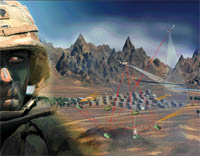CAE is at Paris in buoyant mood having delivered the first combat mission simulator (CMS) developed specifically for the MD Helicopters-built AH/MH-6 'Little Bird'. The simulator is destined for the US Army's 160th Special Operations Aviation Regiment (SOAR) based at Fort Campbell in Kentucky.
In total, CAE is designing and manufacturing three new CMSs for the 160th SOAR. The other two are for the Boeing MH-47G Chinook, and for the Sikorsky MH-60K/L Black Hawk.
The contract for the Little Bird CMS is worth $30 million, while total value of all the contracts CAE has with the 160th is more than $100m.
CAE says the MH-47 CMS will be delivered in spring 2006 and the MH-60 in late 2006. CAE is also due to deliver a reconfigurable MH-47/MH-60 part task trainer as well as MH-47 and MH-60 desktop trainers. These devices are designed for familiarisation training on the new CAAS cockpit going into the regiment's Chinooks and Black Hawks.
The regiment already has an MH-47E and an MH-60 CMS, which CAE has upgraded over the past year with a new CAE Medallion-S visual system. The fact that the 'Little Bird' has never been simulated before meant a significant amount of aircraft testing and data gathering was involved in the development programme. CAE engineers worked closely with the US Army's program executive office for simulation, training, and instrumentation (PEO STRI) and the regiment to gather the necessary aircraft data and handling characteristics to simulate the helicopter accurately.
One of the key requirements of the160th for the Little Bird CMS was an 'extreme field-of-view'.
CAE says: "Because of the missions flown in this aircraft and the pilot's requirement for visual awareness, the regiment wanted a simulator with the most extreme field of view possible. The dome display has a field-of-view measuring 240 degrees by 98 degrees, which we believe is the largestdisplay ever put on a motion-based simulator.
"A significant amount of customer involvement was required for the programme. Since this was a prototype simulator and there was no 'off-the-shelf' data package available, CAE engineers needed to work closely with PEO STRI engineers and 160th personnel, including pilots, to ensure the simulation accurately reflected the flying characteristics of the helicopter."

Source: Flight Daily News























